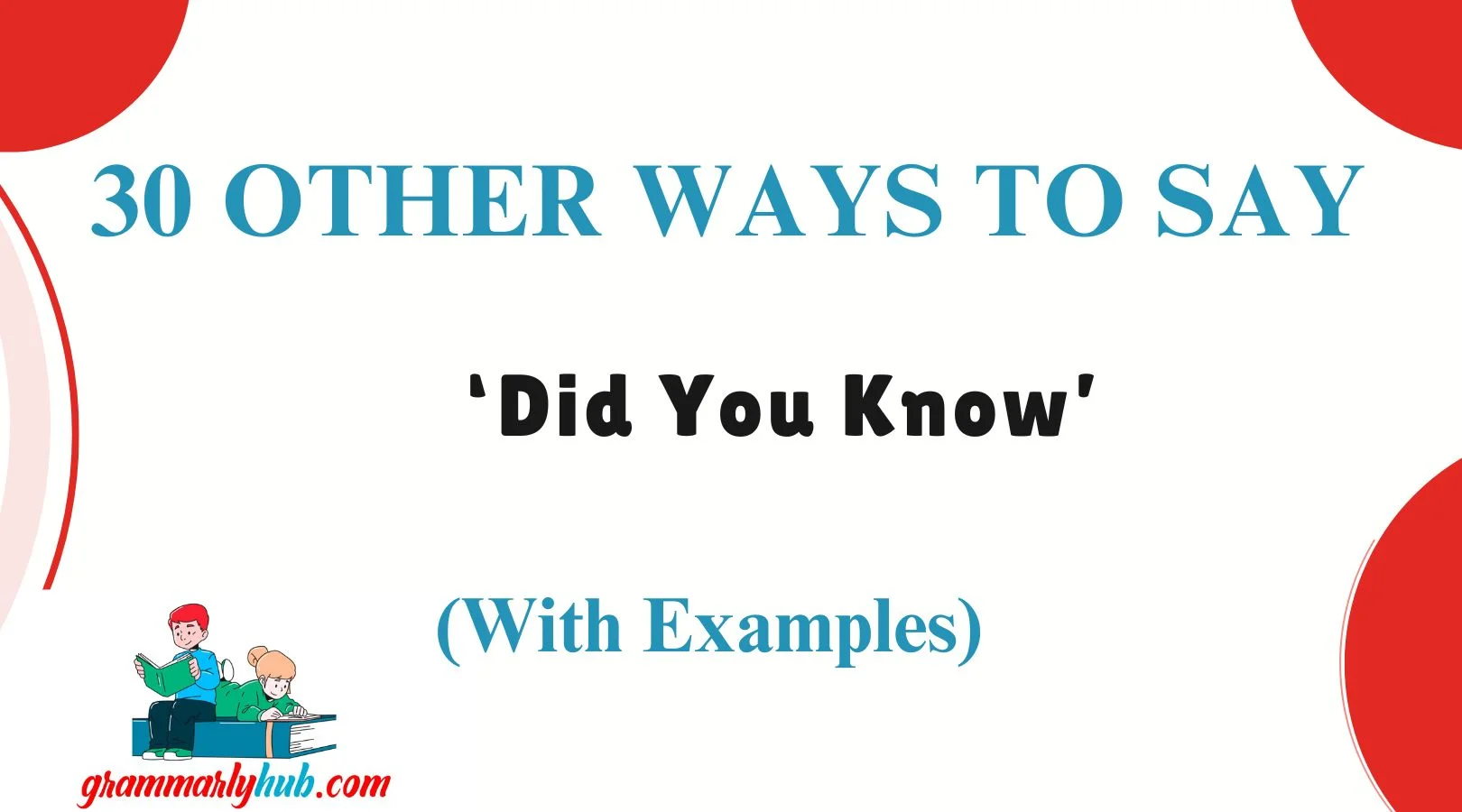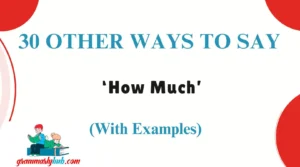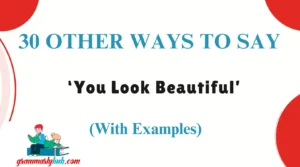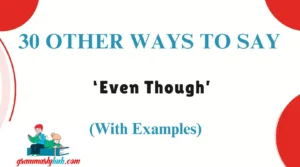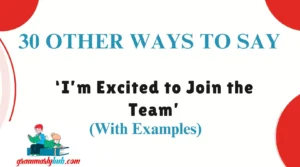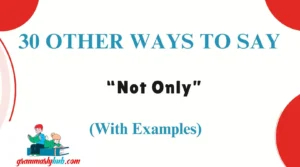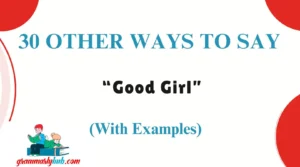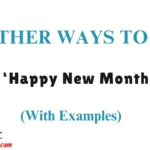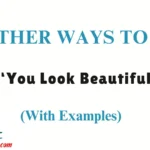Words are powerful. The way we share information can build bridges or create distance. Saying something like “Did you know?” might sound casual, but when used thoughtfully, it can inspire curiosity, connection, or even care.
However, sometimes it’s worth finding gentler, warmer, or more engaging alternatives—phrases that make conversations feel more personal. In this guide, we’ll explore 30 heartfelt and effective alternatives to “Did you know?” and when to use them to express yourself with empathy, thoughtfulness, and clarity.
What Does “Did You Know” Mean?
“Did you know” is a question used to introduce new, surprising, or helpful information. It often implies that the listener may not be aware of what’s about to be shared.It’s commonly used in conversations, presentations, and writing to spark curiosity or draw attention to a fact or insight.Usually inquisitive or informative. It can sometimes come across as blunt if not delivered with care.“Did you know elephants can recognize themselves in a mirror?”
When to Use “Did You Know”
- To introduce interesting facts or statistics
- In storytelling, speeches, or educational contexts
- To gently challenge someone’s assumptions
- When writing blogs, emails, or social media posts
Use it when you want to spark interest or encourage discovery, but keep the tone warm and non-patronizing.
Is It Professional/Polite to Say “Did You Know”?
Yes—but it depends on the context and tone. In formal or professional settings, “Did you know” may sound overly casual or presumptive if not framed carefully. Instead, try using a gentler or more inquisitive tone, especially when communicating with clients, teams, or stakeholders.
Better Alternatives for Formal Use:
- “You might find it interesting that…”
- “It’s worth noting…”
- “Interestingly…”
Pros or Cons of Saying “Did You Know?”
Pros:
- Simple and easy to understand
- Encourages curiosity
- Works well in informal conversations
Cons:
- Can feel abrupt or patronizing if not used with care
- May sound like a quiz
- Not ideal for formal communication
1. Have You Ever Noticed…
Definition: Used to softly bring awareness to a detail or insight.
Explanation: This phrase gently invites someone to consider something they may have overlooked, without sounding accusatory.
Scenario Example: “Have you ever noticed how calm everything gets right before it rains?”
Worst Use: When pointing out someone’s flaws or mistakes.
Tone: Observational, reflective, warm
2. You Might Be Surprised to Learn…
Definition: Hints that the information may be unexpected or enlightening.
Explanation: Sets the stage for curiosity and engagement, while maintaining a polite tone.
Scenario Example: “You might be surprised to learn that sea otters hold hands when they sleep.”
Worst Use: In a debate where it might sound condescending.
Tone: Encouraging, engaging, lightly playful
3. It’s Interesting to Note That…
Definition: Highlights an intriguing or noteworthy detail.
Explanation: Suits both casual and formal settings and focuses attention.
Scenario Example: “It’s interesting to note that honey never spoils.”
Worst Use: In emotional conversations—it may sound cold.
Tone: Neutral, informative, slightly formal
4. You May Not Be Aware That…
Definition: Gently suggests the listener might not have this knowledge.
Explanation: Respectful way to present new info, especially in a teaching context.
Scenario Example: “You may not be aware that this feature was just added last week.”
Worst Use: When used sarcastically—it can sound smug.
Tone: Respectful, professional, considerate
5. Here’s Something Fascinating…
Definition: Directs attention to a captivating idea or fact.
Explanation: Adds a personal flair and emotional curiosity to the conversation.
Scenario Example: “Here’s something fascinating: octopuses have three hearts.”
Worst Use: When the fact is trivial or unrelated.
Tone: Excited, warm, curious
6. Did It Ever Occur to You That…
Definition: A reflective question encouraging deeper thought.
Explanation: This phrase gently nudges someone to consider a possibility or detail they might not have realized.
Scenario Example: “Did it ever occur to you that your small acts of kindness brighten someone’s entire day?”
Worst Use: When used to highlight someone’s oversight or error—it may sound blaming.
Tone: Thoughtful, introspective, caring
7. I Thought You Might Like to Know…
Definition: A soft and personal way to introduce helpful or interesting information.
Explanation: It implies care and consideration, often used when sharing something with emotional warmth.
Scenario Example: “I thought you might like to know that your favorite bakery just reopened.”
Worst Use: When sharing something irrelevant or overly personal without context.
Tone: Friendly, warm, respectful
8. What’s Really Intriguing Is…
Definition: Draws attention to something unexpected or compelling.
Explanation: This phrase works especially well when sharing surprising facts or insights that spark discussion.
Scenario Example: “What’s really intriguing is that whales can communicate across oceans.”
Worst Use: When exaggerating mundane details—it can fall flat.
Tone: Curious, engaging, slightly dramatic
9. It Turns Out That…
Definition: Introduces a realization or outcome, often with a hint of surprise.
Explanation: This phrase often builds suspense before revealing the main point.
Scenario Example: “It turns out that plants can actually ‘hear’ the sound of water.”
Worst Use: In emotionally sensitive topics where the tone might feel too casual.
Tone: Surprising, light, storytelling
10. Just a Quick Insight…
Definition: A concise phrase that introduces a helpful thought or observation.
Explanation: Useful in professional or educational settings when you want to be respectful of someone’s time.
Scenario Example: “Just a quick insight—using clear subject lines can increase email open rates.”
Worst Use: When followed by long or unrelated content.
Tone: Brief, professional, helpful
11. I Recently Learned That…
Definition: Shares a personal discovery in a humble, relatable way.
Explanation: This phrase creates a sense of learning together, rather than instructing.
Scenario Example: “I recently learned that hummingbirds can remember every flower they visit.”
Worst Use: When used repetitively—it can sound like name-dropping facts.
Tone: Personal, open, curious
12. Thought This Might Be of Interest…
Definition: Offers information that may be relevant or useful to someone.
Explanation: Polite and gentle, it works well in emails, messages, or thoughtful conversations.
Scenario Example: “Thought this might be of interest—our department just launched a mentorship program.”
Worst Use: When used to promote something irrelevant.
Tone: Respectful, informative, thoughtful
13. Let Me Share Something You Might Not Expect…
Definition: Builds curiosity before revealing something surprising.
Explanation: A great conversation starter or blog opener, ideal for drawing readers in.
Scenario Example: “Let me share something you might not expect: sharks are older than trees.”
Worst Use: In professional documents—it may sound too informal.
Tone: Engaging, slightly mysterious, informal
14. Here’s a Little-Known Fact…
Definition: Introduces a fact that isn’t widely known.
Explanation: Ideal for educational or engaging content that seeks to surprise and inform.
Scenario Example: “Here’s a little-known fact: sloths can hold their breath longer than dolphins.”
Worst Use: When the fact isn’t really “little-known.”
Tone: Intriguing, playful, informative
15. This May Surprise You…
Definition: Sets up information that might challenge expectations.
Explanation: Creates suspense and keeps the listener or reader curious.
Scenario Example: “This may surprise you, but bananas are technically berries.”
Worst Use: When sharing upsetting news—it may sound too casual.
Tone: Gentle, teasing, engaging
16. Fun Fact:
Definition: A short and cheerful phrase to share light, interesting info.
Explanation: Popular in blogs and social posts, great for creating a positive mood.
Scenario Example: “Fun fact: butterflies can taste with their feet!”
Worst Use: In formal or serious contexts.
Tone: Playful, cheerful, casual
17. Something Worth Mentioning Is…
Definition: A thoughtful way to bring attention to a relevant detail.
Explanation: This phrase works well in professional settings and can be used to introduce helpful tips or side notes.
Scenario Example: “Something worth mentioning is that the update improves accessibility features.”
Worst Use: When used to introduce off-topic or redundant info.
Tone: Professional, considerate, informative
18. Here’s an Eye-Opener…
Definition: Suggests that what follows may challenge someone’s assumptions.
Explanation: Often used to grab attention, especially when the fact feels enlightening or powerful.
Scenario Example: “Here’s an eye-opener: most plastic never fully decomposes.”
Worst Use: In overly casual or humorous settings—it can feel too heavy.
Tone: Bold, thought-provoking, serious
19. You Might Find This Useful…
Definition: A practical phrase for offering helpful advice or tips.
Explanation: Makes the reader feel like the insight is shared for their benefit, not to show off.
Scenario Example: “You might find this useful—adding a CTA at the top of your email increases response rates.”
Worst Use: When sharing personal opinions that may not be relevant.
Tone: Helpful, humble, professional
20. Let’s Uncover Something Unexpected…
Definition: A collaborative phrase that invites exploration.
Explanation: Useful in storytelling, content marketing, or teaching moments to make learning feel like an adventure.
Scenario Example: “Let’s uncover something unexpected: cats can’t taste sweetness.”
Worst Use: When what follows is very predictable.
Tone: Inclusive, exploratory, curious
21. I Came Across This Recently…
Definition: A casual way to introduce something newly discovered.
Explanation: This phrase adds a personal touch, making the shared insight feel timely and relevant.
Scenario Example: “I came across this recently—listening to certain types of music can enhance memory retention.”
Worst Use: When trying to sound authoritative on something just discovered.
Tone: Humble, conversational, open
22. You’ll Never Guess…
Definition: A playful lead-in to surprising or unusual information.
Explanation: This phrase builds anticipation and makes the conversation feel more engaging or lighthearted.
Scenario Example: “You’ll never guess what I found out—octopuses have blue blood!”
Worst Use: When the surprise doesn’t live up to the build-up.
Tone: Excited, playful, energetic
23. Here’s Something You Might Appreciate…
Definition: A thoughtful way to offer information tailored to someone’s interests or values.
Explanation: This phrase shows emotional intelligence, as it suggests you’ve considered what matters to the person.
Scenario Example: “Here’s something you might appreciate—there’s a new eco-friendly packaging solution available now.”
Worst Use: When the content doesn’t align with the person’s values or needs.
Tone: Considerate, warm, emotionally attuned
24. Surprisingly,
Definition: A single-word lead-in that flags something unexpected.
Explanation: Often used to shift a conversation or article toward a surprising fact, making it ideal for short-form content.
Scenario Example: “Surprisingly, flamingos aren’t born pink—they turn pink from their diet.”
Worst Use: When the fact isn’t actually surprising.
Tone: Intriguing, concise, confident
25. This Might Catch Your Attention…
Definition: Highlights something compelling or unusual.
Explanation: Effective in writing and conversation when you want to draw focus quickly and politely.
Scenario Example: “This might catch your attention—companies with diverse teams outperform those without by 35%.”
Worst Use: In urgent scenarios—it may sound too casual or promotional.
Tone: Professional, engaging, slightly bold
26. One Thing You Might Not Realize…
Definition: Gently introduces a detail someone may have overlooked.
Explanation: Useful for clarifying facts, addressing misconceptions, or enhancing awareness.
Scenario Example: “One thing you might not realize is that your browser saves more data than you think.”
Worst Use: When pointing out someone’s mistake in a condescending tone.
Tone: Gentle, informative, respectful
27. I Stumbled Upon This and Thought of You…
Definition: A heartfelt, personal way to share something meaningful or relevant.
Explanation: Conveys care, making it ideal for friendly messages, emails, or social posts.
Scenario Example: “I stumbled upon this and thought of you—it’s a podcast on compassionate leadership.”
Worst Use: When the content feels forced or irrelevant to the person.
Tone: Affectionate, thoughtful, emotionally warm
28. A Curious Thing I Found…
Definition: Frames information as a discovery rather than a lecture.
Explanation: Perfect for blogs, personal storytelling, or introductions to niche facts.
Scenario Example: “A curious thing I found—cows have best friends and get stressed when separated.”
Worst Use: In highly formal or academic writing.
Tone: Playful, curious, informal
29. Let Me Point Out Something…
Definition: A direct way to highlight a specific idea or insight.
Explanation: Works well in structured writing or conversations that call for clarity and focus.
Scenario Example: “Let me point out something—your strongest performing ads have emotional hooks.”
Worst Use: In casual conversations—it may come off as overly serious.
Tone: Clear, focused, professional
30. Here’s a Nugget of Insight…
Definition: A warm and catchy way to introduce a small but meaningful piece of information.
Explanation: Adds personality and makes the reader feel like they’re getting a valuable takeaway.
Scenario Example: “Here’s a nugget of insight—people are more likely to remember facts shared as stories.”
Worst Use: In dry technical documents—it may feel too whimsical.
Tone: Charming, concise, value-driven
✅ Conclusion
Definition: “Did you know?” is a simple phrase, but finding thoughtful alternatives allows us to connect more meaningfully.
Meaning: When we choose our words with warmth and empathy, we turn basic facts into moments of connection.
Explanation: Whether you’re writing a newsletter, giving a talk, or just chatting with a friend, the way you deliver information shapes how it’s received. Using phrases like “I thought you might like to know” or “Here’s a nugget of insight” reflects care, intentionality, and emotional intelligence.
Scenario Example: Instead of saying, “Did you know smiling reduces stress?” try: “Here’s something you might appreciate—smiling even when you’re stressed can calm your brain.”
Best Use: Use these alternatives when you want to inform while also inspiring, connecting, or showing thoughtfulness.
Tone: Empathetic, human-centered, conversational, and SEO-optimized for real impact.
Would you like this article turned into a downloadable Google Doc or formatted for WordPress?
Frequently Asked Questions
Q1: Why should I use alternatives to “Did You Know”?
Answer: Using thoughtful alternatives to “Did you know?” can help you sound more caring, conversational, or professional—depending on your audience. It shows emotional awareness and can make your message more engaging and less abrupt.
Q2: Are these alternatives appropriate for formal writing or business communication?
Answer: Yes! Phrases like “You may not be aware that…” or “It’s interesting to note that…” work beautifully in professional settings. Just be sure to match your tone to your audience—use more relaxed phrases like “Fun fact:” in informal or creative spaces.
Q3: Can these alternatives improve my content’s readability and SEO?
Answer: Absolutely. Variety in language improves both human engagement and search engine understanding. These phrases naturally introduce semantic richness, making your content more relatable and discoverable.
Q4: What is the best alternative to “Did You Know” for social media?
Answer: Try “You’ll never guess…”, “Fun fact:”, or “This might surprise you…” for eye-catching, scroll-stopping hooks. They’re playful, emotional, and perfect for bite-sized content.
Q5: Are these phrases suitable for educational or training materials?
Answer: Definitely. Use alternatives like “Let’s uncover something unexpected…” or “Here’s a nugget of insight…” to keep learners curious and engaged while avoiding overly academic language.
Q6: Can I mix these phrases in the same article or speech?
Answer: Yes, and it’s actually encouraged. Using a variety of warm, natural phrasing keeps your audience interested and creates a more human, relatable tone throughout your content.
Q7: Is it okay to use “Did you know?” occasionally?
Answer: Of course! “Did you know?” is not wrong—it’s just overused. The key is to be intentional. Mix it with alternatives for a more thoughtful, less robotic communication style.

Welcome to GrammarlyHub, your trusted resource for writing clarity, grammar insights, and language tools. Founded by Mia Rose, a passionate writer and language enthusiast, GrammarlyHub is dedicated to helping students, professionals, and creatives write with confidence and precision.
